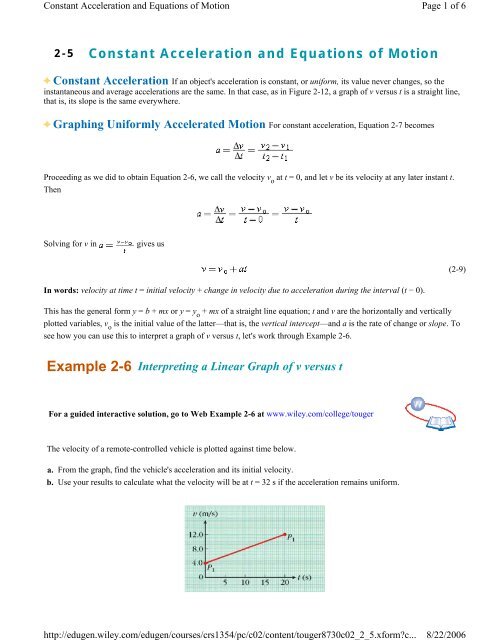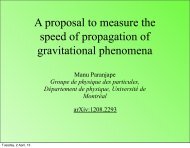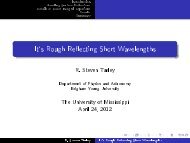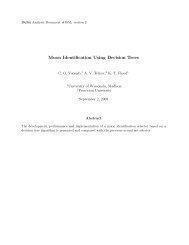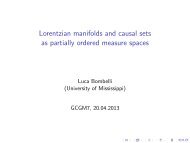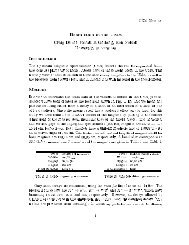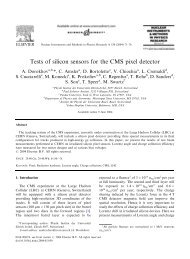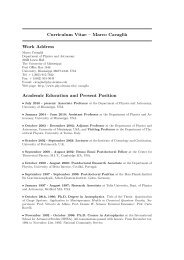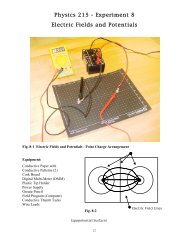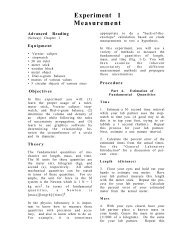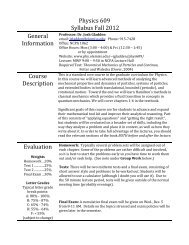2-5 Constant Acceleration and Equations of Motion
2-5 Constant Acceleration and Equations of Motion
2-5 Constant Acceleration and Equations of Motion
Create successful ePaper yourself
Turn your PDF publications into a flip-book with our unique Google optimized e-Paper software.
<strong>Constant</strong> <strong>Acceleration</strong> <strong>and</strong> <strong>Equations</strong> <strong>of</strong> <strong>Motion</strong><br />
http://edugen.wiley.com/edugen/courses/crs1354/pc/c02/content/touger8730c02_2_5.xform?c...<br />
Page 1 <strong>of</strong> 6<br />
8/22/2006<br />
2-5 <strong>Constant</strong> <strong>Acceleration</strong> <strong>and</strong> <strong>Equations</strong> <strong>of</strong> <strong>Motion</strong><br />
<strong>Constant</strong> <strong>Acceleration</strong> If an object's acceleration is constant, or uniform, its value never changes, so the<br />
instantaneous <strong>and</strong> average accelerations are the same. In that case, as in Figure 2-12, a graph <strong>of</strong> v versus t is a straight line,<br />
that is, its slope is the same everywhere.<br />
Graphing Uniformly Accelerated <strong>Motion</strong> For constant acceleration, Equation 2-7 becomes<br />
Proceeding as we did to obtain Equation 2-6, we call the velocity v o at t = 0, <strong>and</strong> let v be its velocity at any later instant t.<br />
Then<br />
Solving for v in<br />
gives us<br />
(2-9)<br />
In words: velocity at time t = initial velocity + change in velocity due to acceleration during the interval (t − 0).<br />
This has the general form y = b + mx or y = y o + mx <strong>of</strong> a straight line equation; t <strong>and</strong> v are the horizontally <strong>and</strong> vertically<br />
plotted variables, v o is the initial value <strong>of</strong> the latter—that is, the vertical intercept—<strong>and</strong> a is the rate <strong>of</strong> change or slope. To<br />
see how you can use this to interpret a graph <strong>of</strong> v versus t, let's work through Example 2-6.<br />
Example 2-6 Interpreting a Linear Graph <strong>of</strong> v versus t<br />
For a guided interactive solution, go to Web Example 2-6 at www.wiley.com/college/touger<br />
The velocity <strong>of</strong> a remote-controlled vehicle is plotted against time below.<br />
a. From the graph, find the vehicle's acceleration <strong>and</strong> its initial velocity.<br />
b. Use your results to calculate what the velocity will be at t = 32 s if the acceleration remains uniform.
<strong>Constant</strong> <strong>Acceleration</strong> <strong>and</strong> <strong>Equations</strong> <strong>of</strong> <strong>Motion</strong><br />
http://edugen.wiley.com/edugen/courses/crs1354/pc/c02/content/touger8730c02_2_5.xform?c...<br />
Page 2 <strong>of</strong> 6<br />
8/22/2006<br />
Brief Solution<br />
Choice <strong>of</strong> approach. Note that v = v o + at has the same form as y = y o + mx.<br />
a. Slope <strong>and</strong> intercept: We can read the vertical intercept directly <strong>of</strong>f the graph (point P 1 ). This is the initial velocity: v o<br />
= 4 m/s.<br />
The acceleration is the slope <strong>of</strong> the graph, which we can find from any two points on the line. In the given graph, we<br />
arbitrarily select points<br />
Thus,<br />
b. Equation <strong>of</strong> motion: Once we know v o <strong>and</strong> a, we can use Equation 2-9 to find v at any value <strong>of</strong> t. Thus,<br />
Note that both terms, v o <strong>and</strong> at, have units <strong>of</strong> velocity.<br />
Related homework: Problem 2-30.<br />
Average Velocity Suppose an object accelerates uniformly from a velocity v o at t = 0 to a velocity v at some<br />
later instant t. The average velocity over this interval will then be midway between the values <strong>of</strong> v o <strong>and</strong> v. In other words, it<br />
is the numerical average <strong>of</strong> these two values:<br />
(2-10)<br />
It is important to realize that this is generally not true when the acceleration is not uniform. Figure 2-15 shows this: in graph<br />
ii, the velocity is below<br />
for most <strong>of</strong> the interval from 0 to t, so its time-averaged value is lower. For graph iii, by<br />
similar reasoning, the average velocity is higher than .
<strong>Constant</strong> <strong>Acceleration</strong> <strong>and</strong> <strong>Equations</strong> <strong>of</strong> <strong>Motion</strong><br />
http://edugen.wiley.com/edugen/courses/crs1354/pc/c02/content/touger8730c02_2_5.xform?c...<br />
Page 3 <strong>of</strong> 6<br />
8/22/2006<br />
Figure 2-15 Average velocities for cases <strong>of</strong> uniform <strong>and</strong> nonuniform motion.<br />
Before solving problems about uniformly accelerated bodies, we should first ask where in the real world do we find bodies<br />
experiencing constant acceleration? We will have more to say about the conditions needed for constant acceleration in<br />
Chapters 4 <strong>and</strong> 5, when we discuss how objects affect one another's motions. For now, we won't try to generalize. We<br />
simply acknowledge that there is constant acceleration when measurements show that there is, <strong>and</strong> we give examples <strong>of</strong> this<br />
occurring.<br />
Range Finder Measurements One way <strong>of</strong> doing the necessary measurements is with a sonic range finder<br />
(or motion detector) connected to a computer (Figure 2-16). S<strong>of</strong>tware loaded into the computer enables it to do calculations<br />
<strong>and</strong> plot graphs using the input from the range finder. The range finder emits ultrasound pulses that travel at constant speed.<br />
It determines how far away a body is by sending out a pulse, detecting the pulse reflected back from the body, <strong>and</strong> timing<br />
the duration <strong>of</strong> the round trip. One common model makes 15 such measurements each second, so that for a moving body,<br />
displacements ∆x can be calculated for tiny intervals ∆t, which are measured by the computer's internal clock. Then, using<br />
, the s<strong>of</strong>tware directs the computer to calculate values <strong>of</strong> average velocities that are approximately instantaneous<br />
because the intervals are so small. From these values, the computer can therefore use to calculate acceleration<br />
values that are likewise approximately instantaneous. Using these simple equations (which do not require a to be uniform)<br />
to do hundreds <strong>of</strong> calculations each second, the computer can find x, v, <strong>and</strong> a at successive clock readings t, <strong>and</strong> it can<br />
display the results as graphs.<br />
Figure 2-16 Range finder set-up for motion measurements.<br />
Figure 2-17 shows two situations for which these measurements are easily done. In 2-17a, the h<strong>and</strong> gives the block a shove<br />
to the right <strong>and</strong> the detector is turned on (t = 0) as soon as the block leaves the h<strong>and</strong>. In 2-17b, the detector is turned on<br />
when the weight strung over the pulley begins to fall. Figure 2-18 shows the resulting graphs. (Compare the x versus t plots<br />
with the graphs for cars B <strong>and</strong> C in Figure 2-8.) The v versus t graphs have constant slope, so the acceleration is<br />
uniform. The a versus t plots reinforce this point: They are horizontal—the value <strong>of</strong> a is not going up or down.
<strong>Constant</strong> <strong>Acceleration</strong> <strong>and</strong> <strong>Equations</strong> <strong>of</strong> <strong>Motion</strong><br />
http://edugen.wiley.com/edugen/courses/crs1354/pc/c02/content/touger8730c02_2_5.xform?c...<br />
Page 4 <strong>of</strong> 6<br />
8/22/2006<br />
Figure 2-17 Making measurements on the motion <strong>of</strong> a block with a range finder.<br />
Figure 2-18 <strong>Motion</strong> graphs for the blocks in Figure 2-17.<br />
Recall that the v versus t graphs (in Figure 2-12) for the carts in Figure 2-13 are also straight lines, so the carts'<br />
accelerations are also constant. In short, there are a variety <strong>of</strong> situations that we can treat as having constant or roughly<br />
constant acceleration.<br />
Example 2-7 A Racing Car Speeds Up<br />
A racing car goes from 30 m/s to 50 m/s over a 5.0-s interval. If the acceleration is constant, how far does it go during this<br />
time?<br />
Solution<br />
Restating the problem. The question asks for a distance traveled during a time interval: What is |∆x| during a particular ∆t
<strong>Constant</strong> <strong>Acceleration</strong> <strong>and</strong> <strong>Equations</strong> <strong>of</strong> <strong>Motion</strong><br />
http://edugen.wiley.com/edugen/courses/crs1354/pc/c02/content/touger8730c02_2_5.xform?c...<br />
Page 5 <strong>of</strong> 6<br />
8/22/2006<br />
<strong>of</strong> 5 s if v changes from v 1 = 30 m/s to v 2 = 50 m/s during this time interval?<br />
What we know/what we don't.<br />
Choice <strong>of</strong> approach. (1) Because the acceleration is constant, the average velocity meets the condition that ,<br />
which we can use to find v . (2) Once we know v , we can use the definition <strong>of</strong> average velocity<br />
to find ∆x.<br />
The mathematical solution.<br />
1.<br />
2. Since .<br />
Related homework: Problems 2-35, 2-36, <strong>and</strong> 2-37.<br />
Completely Describing <strong>Motion</strong> from Initial Conditions Suppose an object starts out at t = 0<br />
with a certain initial velocity v o , <strong>and</strong> it has an acceleration a, which we know is constant. From the definition <strong>of</strong><br />
acceleration, we obtained Equation 2-9, which can tell us the velocity v <strong>of</strong> the object at each subsequent instant t (see<br />
Example 2-6b). To describe the object's motion completely, we would need to know not only its velocity but its position x<br />
(or its displacement x − x o ) at each instant. To find an expression that tells us this, we can reason algebraically from<br />
definitions <strong>and</strong> the condition for constant acceleration.<br />
The definition <strong>of</strong> average velocity (Equation 2-3) now becomes<br />
, so that<br />
But<br />
(Equation 2-10), so<br />
Because we have previously found that v = v o + at, we can use this to substitute for v:<br />
Simplifying the right-h<strong>and</strong> side, we get<br />
(2-11)<br />
If we know the initial values (x o , v o , <strong>and</strong> an a that doesn't change), we can use this equation to find the object's position x at<br />
any later instant t.
<strong>Constant</strong> <strong>Acceleration</strong> <strong>and</strong> <strong>Equations</strong> <strong>of</strong> <strong>Motion</strong><br />
http://edugen.wiley.com/edugen/courses/crs1354/pc/c02/content/touger8730c02_2_5.xform?c...<br />
Page 6 <strong>of</strong> 6<br />
8/22/2006<br />
Compare Equation 2-11 with x − x o = vt, which is valid whenever v is constant. If v does not change from its initial value<br />
v o , then a, its rate <strong>of</strong> change, is zero, <strong>and</strong> Equation 2-11 reduces to x − x o = v o t. Otherwise, the last term on the right-h<strong>and</strong><br />
side <strong>of</strong> Equation 2-11 represents an additional contribution to the position. This contribution is needed because the velocity<br />
is changing.<br />
In describing a body's motion, you may also wish to find its velocity at each position x, without having to know t. To obtain<br />
an equation that does this, we start with what we already know <strong>and</strong> do some algebra:<br />
With these substitutions, we get<br />
For simplicity, we next solve for v 2 rather than v, obtaining<br />
(2-12)<br />
Note that solving for v would then give you<br />
that is, you get both positive <strong>and</strong> negative values <strong>of</strong> v. For a situation like the one in Figure 2-13b, both values are<br />
meaningful because the cart will pass a position x once on its way up <strong>and</strong> again on its way down.<br />
Copyright © 2004 by John Wiley & Sons, Inc. or related companies. All rights reserved.


